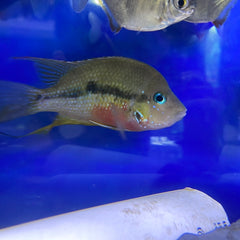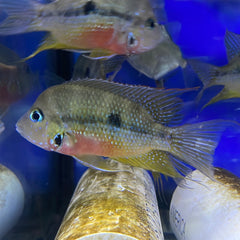Ellioti's Cichlid
The Thorichthys maculipinnis, a medium-sized Central American cichlid, is primarily found in the lower and middle river valleys of the Rio Papaloapan basin in eastern Mexico. These cichlids prefer the company of their own kind and are often seen in groups over sandy substrates, where driftwood and leaf litter provide ample cover. The water clarity in their natural habitat varies, and vegetation is typically minimal, with some areas being a little murky.
To recreate their natural foraging behavior, it is important to keep them in an aquarium with a fine, soft sand substrate. Thorichthys maculipinnis sifts through the substrate in search of food, consuming edible items while expelling inedible material through their gills. Therefore, sharp sand should be avoided. Providing sufficient cover in the form of driftwood and smooth rocks is crucial, leaving an open swimming space along the front of the aquarium. While live plants are not a significant part of their natural habitat, hardy plant species can be added for aesthetic purposes, as these cichlids are not particularly destructive.
To create a more natural environment, leaf litter such as dried Indian almond leaves can be added, but enough space should be left in the sand for the cichlids to sift through. Maintaining good water quality is essential for the well-being of these beautiful fish. High nitrate levels can make them more prone to health problems, so regular water changes are crucial.
Ideally, the aquarium should be at least 4 feet long for juveniles and preferably 5-6 feet long for adults, as these cichlids become territorial when breeding. While a pair can reproduce in smaller tanks, providing more space allows them to exhibit more natural behavior. Though territorial during breeding, Thorichthys maculipinnis is not aggressively combative outside of that time. They often settle minor disputes through bluff and bluster, flaring their gills to appear larger and more intimidating. However, they do not follow through with aggression to the same extent as some other cichlids.
When selecting tankmates, it is best to avoid large, aggressive species as Thorichthys maculipinnis is essentially a shy and peaceful fish outside of breeding. Similarly, diminutive and slow-moving tankmates should be avoided. Robust livebearers like swordtails or goodeids can be kept along with the cichlids in a spacious environment, acting as dither fish to encourage the cichlids out into the open. Some small to medium Central American characins and rainbowfish also make suitable tankmates. Armored suckermouth catfish are generally safe for the lower areas of the tank, but Corydoras should be avoided as they may become targets during spawning.
It's worth noting that while the name T. ellioti has been replaced, many suppliers in the trade still commonly use it.




